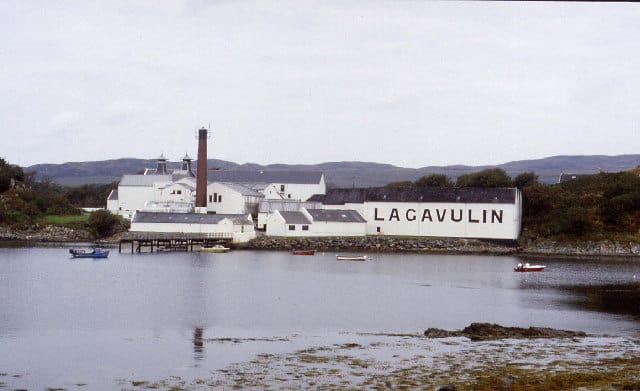Peat has a long association with the Scotch whisky industry. Historically, in many parts of Scotland – particularly Islay and the Western Isles – there were few trees, making peat the only fuel available. When used to fuel kilns drying malted barley, peat imparts “peat reek” to the grain, which gives a distinct, smoky, sometimes phenolic quality to the resulting spirit.
Over the last several decades, there have been two contrary trends in the use of peat. Overall, the level of peatiness in Scotch whisky has decreased. At the same time, the level of peatiness in some heavily peated whiskies has increased dramatically as distillers have vied to produce ever more powerful “peat monsters.” In the process, they’ve created a new category of “super-heavy peated” whiskies.
Dave Reid inspects the quality of the heather filled peat, from Hobbister Moor, in Highland Park whisky distillery, the most northerly distillery in Scotland, on May 30, 2014 in Kirkwall, Scotland. Highland Park is one of two distilleries in the Orkney, the other being Scapa distillery. (Photo by Jeremy Sutton-Hibbert/Getty Images)
The term “peat monster” is a brand name from a particularly heavily peated whisky produced by the specialty bottler Compass Box. Although the whisky industry has no common descriptive usage for the term, in the Scotch enthusiast community, that expression “peat monster” has increasingly been adopted to describe any very heavily peated whisky.
Peat: The Basics
Peat is an accumulation of partially decayed vegetation and other organic matter. Sphagnum moss is one of the most common components of peat, hence the origin of the term peat moss. Peat forms when dead plant material, usually in wet areas, is prevented from decaying fully by acidic and anaerobic conditions.
There are subtle variations created by the raw material that formed the peat. In eastern Scotland, peat was formed primarily from woodlands and moors. It tends to impart a dry earthiness to whisky (Brora, Clynelish, Glen Dronach, Glen Garioch). The Orkney Islands, meanwhile, have no trees. The peat there was formed from decomposed fragrant heather and other vegetation. It can often add dry floral notes to whisky (Scapa).

Islay peat, perhaps the one best-known to Scotch drinkers, consists of mostly decomposed moss and some brush in inland areas, and a combination of decomposed moss, heather, and seaweed along coastal areas.
Sphagnum moss has phenolic compounds embedded in its cell walls, which is the source of the phenolic aromas found in peat. The wetter the area, the higher the proportion of Sphagnum moss in the peat, and the greater its phenolic quantity. In addition, Islay peat is often saturated with salty sea spray. It’s believed that the distinctive medicinal flavors that this peat imparts are the result of the combination of these marine influences with the high amount of moss in the peat (Lagavulin, Laphroaig, Ardbeg, Bruichladdich/Octomore).
Distillers can specify the degree of peating that they want in their malt, measured in parts per million (ppm) phenols. A measurement of one ppm means that there is one milligram of phenol per kilogram of malt (.000016 oz/pound of malt). Generally speaking:
- Lightly peated malt measures two to ten ppm
- Medium peated malt will range around 15 ppm
- Heavily peated malt will range between 25 and 55 ppm
- Super heavy peated malts range from 55 ppm and up
In order to gauge the ppm, phenol levels are measured after the malt has been dried in the kiln. It should also be noted that about a third of the phenol concentration is lost in the distillation process.
Getting Peat Into the Whisky
Kilning is the point in the production process when, if desired, “peat reek” can be introduced into the drying malt. The malt must have a high moisture content in order to absorb the peat smoke, so peat reek has to be introduced at the beginning of the drying process. The amount of peatiness introduced into the drying malt is a result of several factors: the amount of smoke created, the temperature of the smoke, the variety of peat used, and the length of time that the malt is exposed to it.
At Laphroaig, for example, the malt is exposed to peat smoke for about 18 hours. By comparison, at Glengoyne, no peat smoke is used. Wetting down the peat with water can control the amount of smoke produced, and the smoke’s temperature, while it is combusting. The manner in which the peat is introduced into the kiln also has a bearing on how much smoke is produced.
Bowmore is an interesting example of how this all plays out. This distillery, one of the few to still utilize traditional floor malting, has a peat furnace below the kiln floor that dries the green malt. A combination of peat briquettes and coarsely ground peat are used to create heat to dry the malt as well as produce copious quantities of smoke. This is the traditional Islay manner in which green malt was dried before the arrival of modern fuels.
At commercial malters, on the other hand, peat smoke is piped directly into the malting drum, and no peat smoke is allowed to escape through the chimney.
For the curious, the chart below shows a list of the typical levels of peatiness in popular Scotch bottlings:
[visualizer id=”5475″]
In short, both the type of peat and how it is used in the kiln can play an essential role in creating the distinctive character of a Scotch whisky. The impact of variations in the different types of peat used and the kilning process is an area that has not been extensively studied or discussed. No doubt there is a far broader range of kilning techniques than is generally recognized, and such techniques form an important part of a distillery’s proprietary production processes.








